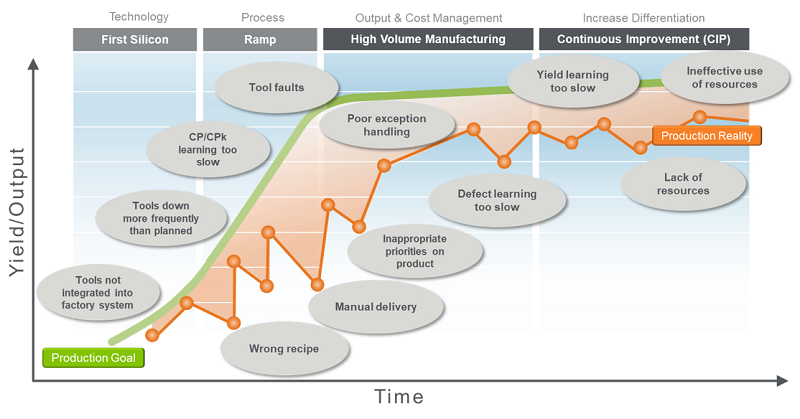From development through production, as device quality and performance specifications become more stringent, factory automation solutions, such as those developed by Applied’s Automation Products Group (APG), enable customers to achieve important yield, output, and cost improvement targets.
In this blog, I highlight the critical aspects of maximizing profitability for a new fab using a framework called the “S curve.” It makes the case for using advanced automation software solutions to add value during the development and transfer-to-volume-manufacturing phases of the fab life cycle.
What’s the S Curve?
- Time (x axis).
- Yield and output (y axis).
- Production goal (heavy green line), or the ideal ramp of output and yield through the phases of development.
- Production reality (orange jagged line) of the ramp that a customer must manage.
- Example issues (grey ovals) that prevent a fab from reaching targeted capacity and yield (note that these are just examples; for some fabs, depending on volume and product, other issues may be more critical).
Driving the S Curve
Not evident in Figure 1 are the critical aspects or factors that a fab must optimize to ensure that production reality meets or exceeds the production goal. These factors are:
- Yield
- Cost
- On Time Delivery
- Output
The effort of optimization—ensuring that production reality meets production goals—is referred to as “driving the S curve.” In your fab, how well do you drive the S curve? What’s required for successfully driving the curve?
The Earlier the Better
The main point of the S curve is that both yield learning and volume production have more value early in the life cycle of a new product, than they do later in the life cycle of that same product. This is because a “new” semiconductor device typically achieves a higher selling price earlier in its life cycle. For a fab costing $20B or more, the area between the green curve and orange line is worth hundreds of millions (if not billions) of dollars. This represents unrealized potential, and time is incredibly valuable throughout this process; a delayed ramp means longer time for returns.
Our Recipe for a Successful Drive
- First silicon. During this phase, customers can begin trial production, shorten their production schedule and learning curve, and increase their production capacity.
- Volume production. During this phase, customers can reduce process variation and wafer scrapping, stabilize yield, increase unit interest rate, and optimize their capacity profitability curve.
- Fully integrated components to eliminate inefficient and disjointed systems, reducing deployment time and IT support costs
- Pre-built automation logic using Applied EngineeredWorks® to increase speed-to-value, enabling quicker deployment times
- Open box approach to eliminate extensive customization costs and enable full user control over fab behavior
Summary
No matter what node or product, today’s semiconductor manufacturing challenges are tough. Fab managers must meet business and production targets—and be able to evolve quickly—to meet changing business and technology requirements.
Whether you need to quickly ramp a new process, run new technologies, or get more out of your installed base, our extensive software capabilities can help you “drive the S curve” to ensure that production reality meets or exceeds your production goal. In this environment, CIM automation, such as that offered with the Applied SmartFactory suite, is critical for achieving important yield, output, and cost improvements at every step of the fab life cycle.



